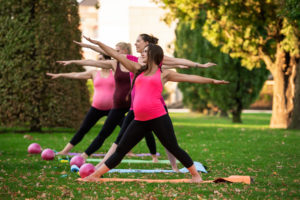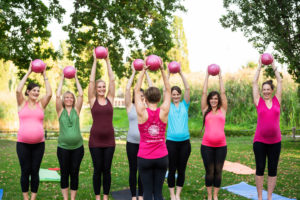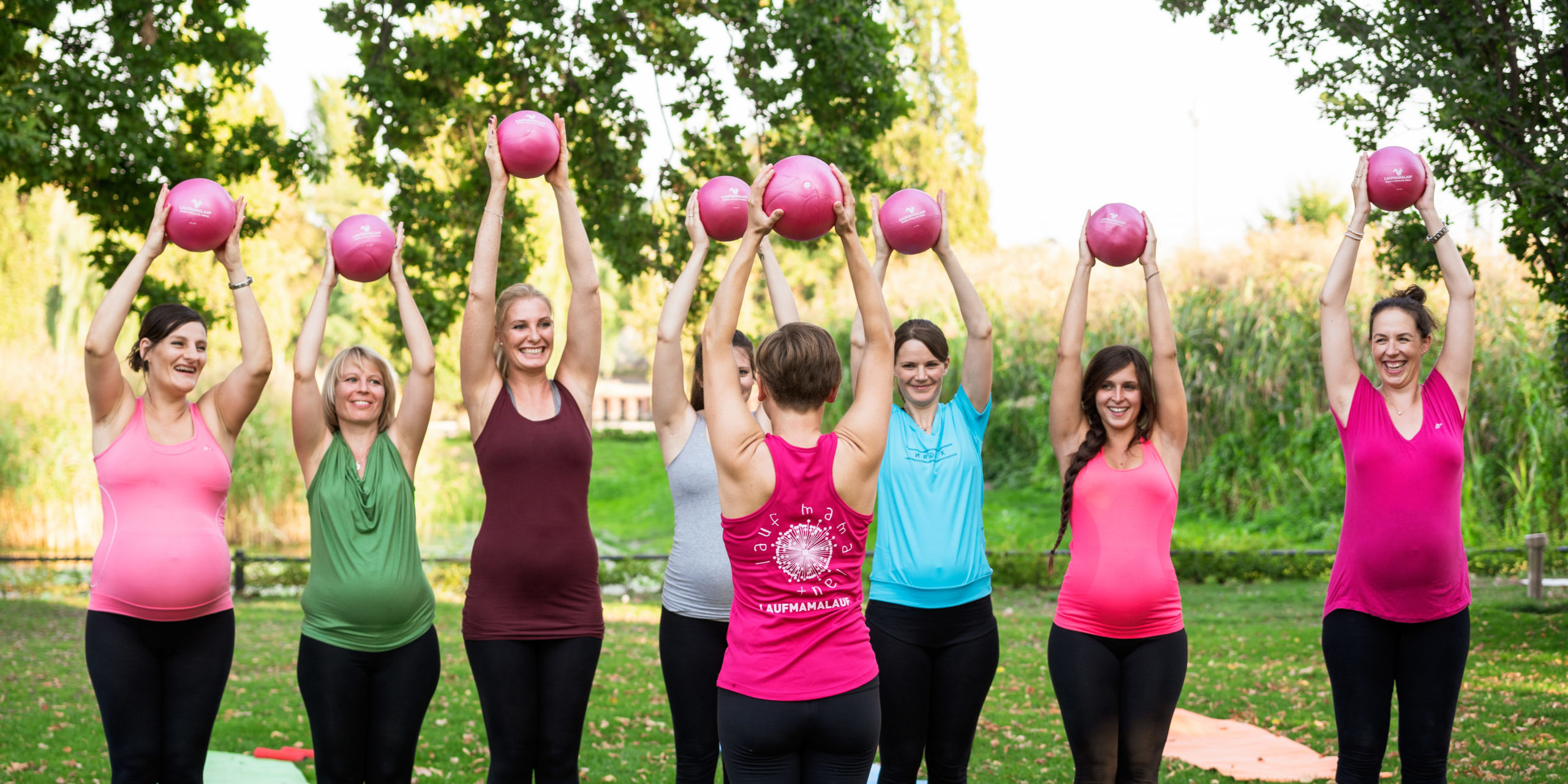Being a mom is great! To continue to feel attractive and self-confident even as a (future) mother is sometimes not always so easy. To support women on their way to this goal is the declared aim of the outdoor fitness provider LAUFMAMALAUF. The clou: No matter if you are an expectant, a new mum or a mother of bigger children: here every mum finds the right training. So get off the sofa and into the park!
The health insurance certified RUNNINGMAMALRUNF concept offers a varied course programme all year round. Competent trainers take an individual approach to the women and help them achieve their personal goals. During a free trial lesson, every (expectant) mum can get an idea of LAUFMAMALAUF for herself.
Sports scientist Katharina Schmidt and physiotherapist Laura Schäuble from LAUFMAMALAUF give tips on fitness during pregnancy and birth.
Do you have any tips on what I should generally pay special attention to when doing sports during pregnancy?
During pregnancy, it is important to listen to your body and be attentive to yourself when exercising. The pregnant woman should not overstrain herself and should only train as much as the current daily form allows. By the number of repetitions as well as the duration and intensity of the exercises, each exercise can be adapted to the individual performance capacity. In our “Ganz-schön-schwanger” courses we therefore work with the so-called Borg scale, which is based on the individual feeling of strain instead of rigid pulse targets, as was common in the past. We recommend a combination of strength and endurance training, moderate stress intensity and regular training to ensure a complication-free pregnancy. One hour before training, a small snack containing carbohydrates and protein should provide a good foundation. And of course it is very important to always drink enough water before, during and after training!
Which complaints from sports during pregnancy should I avoid training?
Moderate exercise during pregnancy is generally recommended for both mother and child and, as the latest studies from Canada show, has a very positive effect on both. As already mentioned, listen to your body! If you feel uncomfortable doing sports, you should kick less or interrupt. Warning signs that require an immediate stop of training and absolutely need medical clarification would be, for example, vaginal bleeding, pain in the back, chest or pelvic floor. But also in case of nausea, dizziness, cardiac arrhythmia, hyperventilation or extreme shortness of breath, an atypical swelling of hands and feet as well as a sudden change in body temperature you should urgently consult a doctor. In addition, there are a number of pre-existing conditions that rule out sport during pregnancy. Our recommendation is to discuss this with your gynaecologist before starting training.
Are there any tips related to the individual trimesters?
During the first trimester many women feel listless and have to cope with nausea. Otherwise, there are hardly any restrictions during this phase.
When training from the end of the 2nd trimester onwards, you should avoid exercises in the supine position. This can lead to the so-called “vena cava syndrome”. If the pregnant woman lies on her back, the baby can press on the inferior vena cava and reduce the blood flow to the heart. Alternatively, one can support oneself on the elbows during these exercises, support the upper body with a pillow or turn on one’s side instead. Preferably on the left side, because that is where the oxygen supply to the baby is best ensured. Exercises in the prone position are also no longer appropriate here and, moreover, usually do not feel good anyway.
In the 3rd trimester, depending on the baby’s capacity, it may be helpful to carry out exercises in a sitting position instead of standing. The focus is on mobilising the pelvis and hip joint, as well as pelvic floor relaxation and stretching. But of course there are also women who exercise a lot and intensively until shortly before delivery and feel wonderful.
Is there any specific equipment that supports a (expectant) mom in healthy training, protects the child etc?
For the (expectant) mum, well-fitting stable sports shoes that support ligaments and tendons are an absolute must. These minimize the risk of injury, because especially during pregnancy tendons and ligaments become more flexible under the influence of hormones. Wide, breathable (functional) clothing based on the onion principle prevents overheating or hypothermia. To provide good support for the breasts, a comfortably fitting sports bra is recommended. From the 2nd trimester onwards, wearing compression stockings or tights, nursing pads or a Bellyband can also be beneficial.
For example, if I like jogging, are there certain periods during pregnancy when I should not run?
Jogging is allowed during a pregnancy free of complications, and for as long as it is good for the mother. If you feel fit enough and are healthy, you can even run until the end of the pregnancy. Again, it is essential to consult your gynaecologist before starting training and rule out any contraindications. In the event of acute infections, abdominal and pelvic floor pain or vaginal bleeding, it goes without saying that training should be discontinued.
Is there an alternative sport that I can do if I am not allowed to jog as a pregnant woman?
Instead of jogging you can simply shift down a gear and take it easy with walking or Nordic walking. Exercise in the water such as swimming or pregnant women’s aqua fitness is also well tolerated. Many expectant mothers find this very pleasant, as they can move around here without any problems. Cycling, gymnastics, yoga, dancing and hiking are also recommended.
If I have not done any sports before, is it still okay to start doing them during pregnancy?
Exercise is good for you. If the expectant mother feels well and the pregnancy goes without complications, there is no reason not to start with gentle exercise at this stage. However, one should avoid starting with an unusual, risky or intensively practiced sport at the beginning of pregnancy. For example, if you have not jogged before, you should not necessarily start during pregnancy. However, a moderate workout such as yoga or Pilates is recommended and is good for body and soul.

How many weeks after giving birth can I start training again?
It is recommended to start training at the earliest 6 weeks after the birth, i.e. only after the final examination by the gynaecologist. In case of a caesarean section a little later – at the earliest after 8 weeks. The suitable starting date always depends on the individual physical regeneration after the birth. It is advisable to seek medical advice beforehand and have your fitness for training confirmed. We also advise all mothers to start regular recovery exercises at home as early as possible after the birth, and above all to train the pelvic floor in everyday life. This even works when ironing or washing up! And please, dear mothers: Take part in a good back-formation course. Even if you don’t (yet) have any problems with your pelvic floor today, in old age incontinence can occur if you don’t do anything.
Do you have any dietary tips for pregnant women AND newly born mothers to lose weight as healthily as possible after the birth?
Losing weight after pregnancy is often an issue in maternal circles, but it should never be a priority. After all, the body has just completed nine months of peak performance and often finds itself in the next energy-sapping process after breastfeeding. You should not forget this and therefore not put yourself under unnecessary pressure.
If you basically enjoy a healthy and varied cuisine with lots of fresh food and don’t skip any meal, you are already well advised. Just don’t go on a diet, because losing weight quickly is unhealthy and all too often leads to the yo-yo effect. You should also drink a lot (1.5 – 2 litres) and make sure you take in enough minerals, trace elements and vitamins. Those who additionally increase their energy consumption through more exercise have the best chance of getting back into shape in the long term.
What possibilities are there to get back into sports after pregnancy?
As already mentioned: The first step for most mothers is recovery gymnastics. Every woman who has gone through a pregnancy has a pelvic floor that has been exposed to extreme stress for months. Now it is time to gradually strengthen it again. In our RUNNING MAMA CURRICULES we also specifically address the problem zone of the pelvic floor and include Pilates elements in the exercises in addition to yoga. The mothers enjoy the gentle introduction and the joint training with their babies, who are also actively integrated into the movements.

More tips and information at www.laufmamalauf.de







